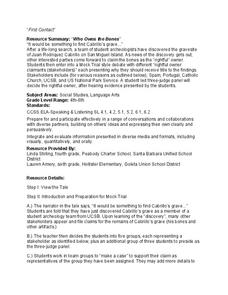Curated OER
Functions and Graphs -- Pattern Detection #1
Middle schoolers discuss the job of an archaeologist by determining how people have used their environment. Using a graph, they analyze the patterns and functions of Native Americans in Arizona using maize. They work together to answer...
Curated OER
Work Made Easy
Second graders maneuver placement of the fulcrum on the lever to see how to lift weight most easily. They role-play as archaeologists with the task of lifting a heavy rock from the dig site. They write in science journals about what...
Curated OER
Ancient Recipes
Students explore how foods and their preparation differ over time and from culture to culture. An ancient recipe for the preparation of goat, found by archaeologists, is examined and discussed by the students.
Curated OER
Saugus Iron Works
Students investigate the 17th century Saugus Iron Works. They role-play archaeologists, research local industries and write a report, and explore various websites regarding the Industrial Revolution and the Saugus Iron Works.
Curated OER
Functions and Graphs -- Pattern Detection #2
Students examine a graph made by archaeologists. In groups, they discuss the role of the size of the animals and how that affects the graph. They compare and contrast the size of animals killed by people 10,000 years ago and 8000 years...
Curated OER
Archeological Finds
Students explore archeology and it contributions to human history. They write a magazine article describing the discovery of a dig.
Ocean Explorer
Looking for Clues
Upper graders become "shipwreck detectives" by studying the debris field from a shipwreck in the Aegean Sea which took place in the 700s. A website is accessed that gives specific information about the debris field, and pairs of...
Curated OER
Replacing Missing Links in the Evolutionary Chain
Examine the evolution of various species of hominids from their earliest existence approximately 4.5 million years ago to today. In small groups, learners research one of the ten stages of hominid evolution and then create a poster and...
Curated OER
Finding James Fort
Welcome to Jamestown! Third and fourth graders read and analyze primary source documents about Jamestown or Fort James. They read and analyze descriptions of Fort James from primary sources. They access a website to explore more...
Curated OER
Stone Tools of Texas Indians
Provide background information regarding the use of stone tools from the paleoindian through the late prehistoric periods. Learners can read this informational passage to gain insight on how and why we study these amazing artifacts from...
Curated OER
Archeology Lesson; Making Inferences
Young scholars discover what an archeologist is and make inferences about societies and cultures based on artifacts. In this archeology lesson, students complete an array of captivating activities, guessing about what an...
Curated OER
Clay Wipe Away: Ceramics
Discuss Pre-Colombian South American art with your class, then get out the clay and create some. Pupils practice using the wipe-away technique to create a ceramic tile similar to those made by the Maya. Great web links and a...
Mississippi Department of Archives and History
Protesting Violence without Violence
The ultimate legacy of Emmett Till's violent death is its role in the non-violent roots of the Civil Rights Movement. A lesson compares contemporaneous articles with the lyrics of Bob Dylan's "The Death of Emmett Till" and prompts...
Curated OER
Grid Frame Mapping
Students map and describe small area of the schoolyard and discuss habitats.
Curated OER
Egyptian Relic: Ceramics Lesson
Egyptian artwork is inspiring in so many ways. Learners discover the world of Egyptian relics as they make a ceramic version of their own. Multiple resource links and full instructions make this a fun and easy-to-incorporate art project...
Curated OER
Salt of the Earth: A Caddo Industry in Arkansas
Middle schoolers explore the history of the Caddo Salt Industry found in Arkansas. Along with learning about how salt deposits formed in Arkansas, learners study the process of salt production and how valuable salt is as a natural...
Curated OER
Jamestown Changes
Students examine how the Jamestown settlement changed the first few years after it was founded. They take a virtual field trip of Jamestown, read primary source documents, discuss census information, and write a summary of changes in...
Curated OER
The Roving Robotic Chemist
Junior oceanographers and underwater geologists describe the four major steps of mass spectrometry. They compete in small groups to simulate the tracking of a deepwater methane plume using imaginary autonomous underwater vehicles. Give...
Curated OER
Ramses The Great
Students investigate the statue that memorialized Ramses II. In this world monuments activity, students research national and local monuments to find out if there are any controversies regarding their construction....
Curated OER
Roman Holiday in Google Earth
Students plan an itinerary for an educational trip to Rome. In this research skills instructional activity, students use Google Earth to conduct research for their project in their travel teams. Students also set up blogs to share their...
Southern Nevada Regional Professional Development Program
Pardon Me, Your Modifier is Dangling
Lost! (or misplaced) a modifier. Last seen dangling at the end of a sentence! Reward offered! To underscore the humor, class members are each given a sample sentence to illustrate (A woman passed by, leading a Springer Spaniel, in a...
Advocates for Human Rights
Who are Immigrants?
What do Jerry Yang, Patrick Ewing, John Muir, Charlize Theron, Peter Jennings, and Saint Frances X Cabrini all have in common? They are all immigrants to the United States. Famous and not-so-famous immigrants are the focus of a resource...
Channel Islands Film
Who Owns the Bones
A study of the history of the Channel Islands, located off the coast of southern California, continues as class members conduct a mock trial to determine which group of stakeholders should have the right to claim the remains of Juan...
Channel Islands Film
Dark Water: Lesson Plan 3 - Grades 6-12
After watching the documentary Dark Water about a traditional Chumash ceremony and reading a Chumash origin story, viewers are asked to create a coat of arms and to craft an essay that details a family tradition or their own origin story.
Other popular searches
- Archaeology Math
- Archaeology Videos
- Art and Archaeology
- Science Archaeology
- Archaeology Recording Form
- Archaeology Internet
- Archaeology Animal
- Material Culture Archaeology
- Olympic Archaeology
- Music and Archaeology
- Archaeology of the Future
- Archaeology Alaska

























